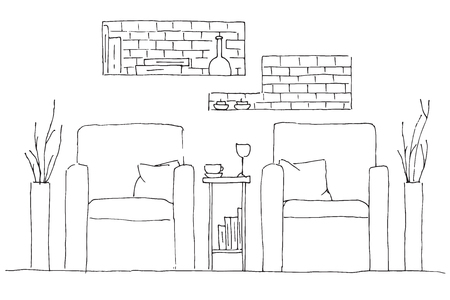Introduction to Scandinavian Design Philosophy
Scandinavian design has long captivated interior enthusiasts worldwide, but its core ethos finds a particularly welcoming home within contemporary British living rooms. Rooted in the principles of simplicity, functionality, and warmth, Scandinavian interiors evoke an effortless elegance that speaks to the sensibilities of modern British homeowners. This design philosophy strips away unnecessary ornamentation in favour of clean lines and uncluttered spaces, yet never compromises on comfort or practicality. By blending light, neutral palettes with natural materials and thoughtful layouts, Scandinavian-inspired spaces create an inviting atmosphere that encourages relaxation and togetherness—qualities that resonate deeply with British lifestyles. As urban living spaces across the UK grow ever more compact, the minimalist approach championed by Scandinavian design offers an appealing solution: every piece serves a purpose, and every corner is imbued with intention. In this article, we delve into how these timeless design principles seamlessly integrate with contemporary British tastes, shaping living rooms that are both stylish and profoundly liveable.
2. Embracing Minimalism in British Living Rooms
Scandinavian minimalism, renowned for its clean lines and understated elegance, finds a distinct resonance within British homes when thoughtfully adapted to local sensibilities. The essence of this approach lies in paring back unnecessary ornamentation while celebrating the character inherent in both traditional and modern British architecture. For those seeking a harmonious blend, consider how minimalist layouts can be tailored to suit period properties with ornate cornicing or contemporary flats with open-plan designs.
Integrating Minimalist Principles into British Spaces
Minimalist living rooms in the UK often require a sensitive balance between retaining architectural heritage and introducing Scandinavian simplicity. In Victorian or Georgian homes, for example, original fireplaces and decorative mouldings become focal points amid pared-back furnishings. Conversely, new-build apartments benefit from open sightlines and natural light, key elements of Scandinavian design philosophy.
Architectural Feature |
Minimalist Adaptation |
British Touch |
|---|---|---|
| Victorian Bay Window | Use low-profile seating to maximise light flow | Add textured cushions in heritage hues (e.g., deep green, navy) |
| Original Fireplace | Keep mantel uncluttered; single statement artwork above | Select local ceramic pieces or framed botanical prints |
| Modern Open-Plan Layout | Zone areas with subtle rugs and modular furniture | Incorporate wool throws or tweed accents for warmth |
| Exposed Brickwork | Pale neutral walls to offset texture; simple shelving | Add vintage market finds or classic British pottery |
The Fusion of Comfort and Restraint
Unlike the stark minimalism seen elsewhere, British interpretations prioritise comfort without visual clutter. Layering soft textiles—think woollen throws and linen cushions—ensures that even the most streamlined spaces feel inviting. The palette remains subdued but not sterile: muted greys, sage greens, and gentle taupes reflect Britain’s landscape while maintaining Scandinavian clarity.
Respecting History While Looking Forward
This fusion allows homeowners to celebrate historical features rather than conceal them. Consider sanded floorboards left bare or lightly stained, paired with sleek Scandinavian-inspired furniture. Lighting is equally important—opt for understated pendant lamps or classic Anglepoise task lights for functional yet beautiful illumination.
Key Takeaways for Modern British Homes:
- Edit possessions ruthlessly but keep meaningful heirlooms as part of the décor.
- Maximise natural light through clever window treatments and furniture placement.
- Introduce greenery with understated indoor plants for a fresh, lived-in feel.
- Choose multi-functional furniture that supports both socialising and relaxation.
The result is a living room that feels authentically British yet effortlessly modern—a space where past meets present through the lens of Scandinavian-inspired minimalism.

3. The Palette: Neutral Tones and Natural Materials
One of the most distinctive features of Scandinavian-inspired minimalist living rooms is their calming palette, which resonates beautifully with contemporary British tastes. Monochrome and gentle neutral shades such as soft greys, off-whites, oatmeal, and muted taupes create a serene backdrop that feels both timeless and fresh. This understated approach to colour not only amplifies natural light—a prized asset in many British homes—but also sets the stage for subtle sophistication.
The synergy between natural materials and this restrained palette is where Scandinavian and British sensibilities truly align. Think elegantly grained oak flooring underfoot, tactile wool throws draped over a classic Chesterfield sofa, or simple ash wood coffee tables paired with linen-upholstered armchairs. These elements introduce warmth and texture, preventing the space from feeling stark or clinical while maintaining a sense of visual calm.
Britain’s love for craftsmanship finds common ground with the Scandinavian ethos of honest materials and functional beauty. Incorporating local finds—like handcrafted ceramics or woven baskets—alongside Scandinavian-inspired furnishings adds an authentic layer that grounds the look in its British context. The result is a living room that balances minimalism with comfort; it’s inviting without excess, sophisticated yet approachable.
4. Furniture Selection: Form Meets Function
When curating a Scandinavian-inspired living room for contemporary British homes, choosing the right furniture is essential to harmonise aesthetics with practicality. Scandinavian design is celebrated for its clean lines, understated elegance, and dedication to functional beauty. These qualities seamlessly complement British lifestyles, where flexibility and comfort are prized due to diverse living arrangements, from Victorian terraces to modern flats.
Iconic Scandinavian Pieces
Several classic Scandinavian furniture pieces have stood the test of time, renowned for their simplicity and craftsmanship. Consider incorporating these iconic items:
Iconic Piece |
Designer/Brand |
Key Features |
|---|---|---|
| The Egg Chair | Arne Jacobsen | Sculptural curves, enveloping form, statement piece |
| The Wishbone Chair | Hans J. Wegner | Lightweight frame, woven seat, timeless silhouette |
| Stockholm Sofa | IKEA | Sleek profile, plush comfort, affordability |
| The String Shelving System | Nisse Strinning | Modular storage, open shelving, adaptable design |
| Coffee Table 80B | Alvar Aalto | Bent plywood legs, minimalist top, organic shape |
Accessible Alternatives for British Homes
While original designer pieces are desirable, they may not always suit every budget or fit perfectly into British living rooms—which often require clever use of space. Fortunately, high street brands offer accessible alternatives that uphold the spirit of Scandinavian design while catering to local proportions and practicalities.
Alternative Brand/Item |
Description & Benefits for UK Homes |
|---|---|
| John Lewis ANYDAY Range | Affordable sofas and armchairs with streamlined silhouettes suitable for smaller British lounges. |
| IKEA LÖVBACKEN Side Table | Compact footprint; ideal as a multifunctional accent piece in tight spaces. |
| M&S Scandi Coffee Tables | Solid wood construction; brings warmth and practicality without overpowering a modest room. |
| Habitat Modular Storage Units | Flexible configurations; perfect for maximising storage in urban flats or period properties. |
| Dunelm Soft Furnishings Collection | Pale linens and textured throws echo Nordic cosiness at an accessible price point. |
The key is to select furnishings that marry pared-back elegance with everyday usability. Opt for pieces in pale woods, neutral textiles, and gentle curves to create a tranquil backdrop—while ensuring each item serves a purpose. Embrace multi-functional designs such as storage ottomans or extendable tables to adapt effortlessly to guests or family needs. By blending iconic influences with thoughtful alternatives tailored to British homes, your living room will reflect both Scandinavian sophistication and UK sensibility.
5. Accents and Accessories: Understated British Style
When curating a Scandinavian-inspired minimalist living room for contemporary British homes, selecting the right accents and accessories is essential to achieve a harmonious balance between Nordic restraint and quintessential British charm. The key lies in embracing simplicity while allowing personality to quietly shine through.
Soft Furnishings with Subtle Textures
Opt for soft furnishings such as cushions and throws in muted tones—think sage greens, gentle greys, and creamy off-whites—that echo the natural palette of both Scandinavian and British interiors. Choose tactile fabrics like linen, wool, or cotton to add depth without overwhelming the senses. For that classic British touch, incorporate understated patterns such as herringbone or plaid in a subdued manner, ensuring comfort and warmth remain at the forefront.
Artful Restraint in Wall Décor
Minimalist wall art plays a pivotal role in this design narrative. Select pieces that feature serene landscapes or abstract forms in neutral hues, reflecting both the British countryside and Scandinavian tranquility. Gallery walls should be sparse—a single well-chosen print or a pair of coordinated artworks can make a refined statement without creating visual clutter.
Timeless Accessories that Tell a Story
Accessories should be curated thoughtfully: opt for handcrafted ceramics, vintage books, or simple glass vases filled with seasonal British blooms. These elements lend authenticity and character while adhering to a pared-back aesthetic. Avoid excessive ornamentation; instead, let each object serve a purpose or evoke a meaningful memory. This approach celebrates the best of both worlds—Scandinavian minimalism and British storytelling tradition—resulting in a space that feels inviting yet impeccably edited.
6. Lighting: Creating Hygge in a British Context
When designing a Scandinavian-inspired minimalist living room for contemporary British homes, lighting becomes more than mere functionality—it transforms the mood and anchors the sense of hygge. In the UK, where overcast skies and shorter daylight hours are part of daily life, harnessing both natural and layered lighting is essential for warmth and comfort.
The Power of Layered Light
Layered lighting is at the heart of Scandinavian design, and it finds a natural home in British spaces craving cosiness. Instead of relying solely on overhead lights, combine ambient, task, and accent lighting throughout your living room. Think understated pendant lamps paired with directional floor lamps next to reading chairs, and soft-glow wall sconces that highlight architectural features or curated shelves. Mixing these elements allows you to adapt the atmosphere from bright and energetic during the day to intimate and soothing come evening.
Embracing Natural Light—Even Under Grey Skies
Despite Britain’s reputation for cloudy weather, making the most of available daylight is key. Maximise window space by opting for sheer curtains or light linen blinds that let in diffused sunshine while retaining privacy. Position mirrors strategically to reflect natural light deeper into the room, enhancing brightness without cluttering the minimalist aesthetic. If privacy isn’t an issue, leave windows unadorned to fully embrace any sunlight that breaks through.
Crafting a Hygge-Inspired Ambience
The Danish concept of hygge centres around creating a warm, inviting sanctuary—a perfect antidote to Britain’s often-grey outlook. Achieve this through warm-toned bulbs (think soft whites rather than harsh blues), dimmer switches for customisable mood settings, and candles clustered on coffee tables or mantels for flickering charm. Incorporate tactile elements like wool throws or textured cushions near light sources to amplify cosiness without overwhelming the pared-back style.
By thoughtfully layering light sources and celebrating what little natural illumination Britain offers, you can capture the spirit of Scandinavian minimalism while infusing your living room with a uniquely British sense of comfort. The result is an environment that feels serene yet welcoming—no matter how grey the sky outside may be.
7. Sustainable and Local Choices
In contemporary British homes, the Scandinavian influence extends beyond aesthetics to embrace sustainability and conscious consumption. As minimalism becomes a lifestyle rather than just a visual trend, many homeowners are seeking ways to curate their living spaces with the environment in mind. Opting for locally sourced British furniture, handcrafted from responsibly managed woods or recycled materials, is an ideal way to support local artisans while reducing your carbon footprint. Complement these pieces with Scandinavian-inspired sustainable design choices—think organic textiles, eco-friendly paints, and timeless accessories crafted from natural fibres. By prioritising quality over quantity and investing in durable, ethically made furnishings, you create a living room that’s not only stylish but also kind to the planet. Blending British craftsmanship with Scandinavian simplicity, you can enjoy a space that feels both authentically local and globally conscious—a reflection of modern British values rooted in sustainability and mindful design.


